Introduction: The Painter of Petals
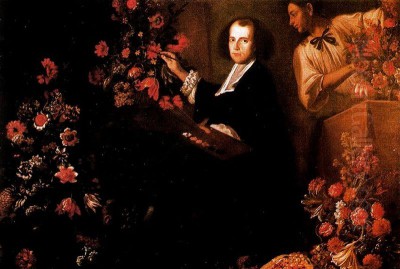
In the vibrant artistic milieu of 17th-century Rome, a city teeming with creative energy and papal patronage, Mario Nuzzi (1603-1673) carved a unique and enduring niche for himself. While many contemporaries focused on grand historical narratives or profound religious scenes, Nuzzi dedicated his exceptional talent primarily to the depiction of flowers. His mastery in this genre earned him the affectionate and descriptive moniker "Mario dei Fiori" – Mario of the Flowers – a name that became synonymous with the lush, detailed, and brilliantly executed floral still lifes that captivated patrons across Italy and beyond. As a key figure in the development of Baroque still life painting in Italy, Nuzzi's work bridges the naturalistic intensity inherited from Caravaggio with a decorative elegance perfectly suited to the opulent tastes of his era.
Early Life and Artistic Formation in Rome
Mario Nuzzi was born in Rome in 1603, entering a world where the artistic revolutions of the High Renaissance were giving way to the dramatic dynamism of the Baroque. His artistic inclinations found fertile ground within his own family. He was the nephew of Tommaso Salini (c. 1575–1625), a notable painter in his own right. Salini was an early follower of Michelangelo Merisi da Caravaggio, adopting the master's revolutionary use of chiaroscuro (strong contrasts between light and dark) and his commitment to naturalism. Salini himself was known for genre scenes and some still lifes, providing a direct link for the young Nuzzi to the Caravaggesque style that was profoundly shaping Roman art.
It is highly probable, and widely accepted by art historians, that Nuzzi received his initial artistic training in his uncle's workshop. This apprenticeship would have exposed him not only to the technical aspects of painting – grinding pigments, preparing canvases, mastering brushwork – but also to the specific stylistic tenets of Caravaggism. Learning under Salini meant Nuzzi likely absorbed the importance of direct observation from life, the dramatic potential of light, and a certain earthy realism, even when applied to the delicate subject of flowers. Salini's established presence in the Roman art market also likely provided Nuzzi with crucial early connections and potentially an initial client base upon his uncle's death in 1625.
The Emergence of "Mario dei Fiori"
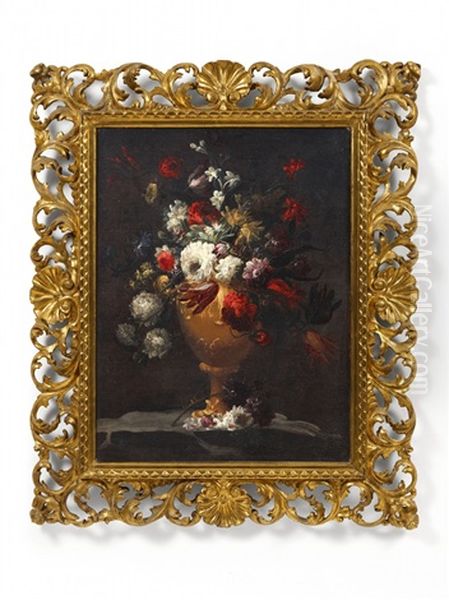
Following the death of Tommaso Salini, Mario Nuzzi began to forge his own path, increasingly specializing in the genre that would define his career: flower painting. While Salini had included still life elements, Nuzzi elevated it to his primary focus, developing a skill and reputation that soon led to his famous nickname, "Mario dei Fiori." This specialization was timely, as still life painting, particularly floral compositions, was gaining popularity as an independent genre across Europe, valued for both its decorative qualities and its potential for conveying symbolic meaning.
Nuzzi's early works likely showed a strong adherence to Salini's style, characterized by relatively dense compositions and the dramatic lighting typical of the Caravaggisti. He quickly established himself within the Roman art market, possibly working initially with art dealers like Francesco Salucci and Francesco Raspini, who facilitated the sale and dissemination of works by many artists. His connection through his uncle to influential figures like Cassiano dal Pozzo, a renowned scholar, collector, and patron with a deep interest in natural history, would also have been invaluable. Dal Pozzo's patronage and network could have significantly boosted Nuzzi's early career, exposing his work to a discerning and affluent clientele.
Artistic Style and Technical Mastery
Mario Nuzzi's style is firmly rooted in the Baroque, characterized by dynamism, richness, and a heightened sense of realism. While the influence of Caravaggio, likely transmitted through Salini, is evident in his use of light and shadow, Nuzzi adapted these principles to the specific demands of flower painting. He employed chiaroscuro not just for drama, but to meticulously model the forms of petals and leaves, giving them a tangible sense of volume and presence. Light in his paintings often falls strategically, highlighting the textures of delicate blooms against darker, receding backgrounds, making the flowers seem to almost emerge from the canvas.
His commitment to naturalism was profound. Nuzzi's flowers are rendered with remarkable botanical accuracy, suggesting careful observation from life, possibly aided by botanical illustrations – indeed, he is known to have contributed illustrations to publications like Fiori Diversi. This scientific precision, however, did not result in stiff, clinical depictions. Instead, he imbued his subjects with vitality. He captured the subtle variations in color, the delicate curl of a petal, the velvety texture of a leaf, and even the occasional wilting bloom or insect, adding a touch of vanitas – a reminder of life's transience – common in still life painting.
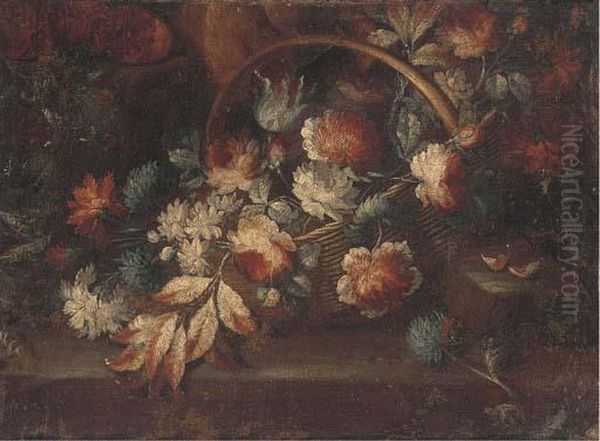
Nuzzi's color palettes were typically rich and vibrant, celebrating the natural beauty of his subjects. He skillfully juxtaposed different hues to create harmonious yet lively compositions. His brushwork could range from highly detailed passages, rendering intricate details with fine brushes, to broader, more fluid strokes in other areas, contributing to the overall sense of energy. Compositionally, his works often feature elaborate bouquets arranged in ornate vases, baskets, or as decorative garlands. These arrangements, while appearing natural, were carefully constructed for balance, rhythm, and visual impact, often displaying a Baroque preference for abundance and complexity.
Major Works and Recurring Themes
While attributing specific works definitively can sometimes be challenging due to workshop practices and imitators, several paintings are strongly associated with Mario Nuzzi and exemplify his style. Among his most characteristic works are numerous compositions simply titled "Vase of Flowers" or similar descriptions. These typically feature a profusion of blooms – tulips, roses, carnations, irises, and other species popular in the 17th century – spilling artfully from a decorative container, often a sculpted urn or a glass vase that allowed Nuzzi to showcase his skill in rendering reflective surfaces. These works highlight his ability to combine botanical accuracy with a sense of luxurious abundance.
Another fascinating aspect of his oeuvre includes paintings featuring birds alongside flowers, such as the theme sometimes referred to as the "Bird Concert" or "Choir of Birds." These compositions allowed Nuzzi to demonstrate his versatility and keen observation skills beyond flora, capturing the varied plumage and lively interactions of different bird species amidst floral settings. These works often possess a charming, almost narrative quality.
Nuzzi also participated in a distinctive Roman practice: painting elaborate floral decorations on mirrors, often in collaboration with figure painters. A notable example is the "Mirror Decorated with Putti, Flowers and Acanthus Scrolls," where Nuzzi's exquisite floral garlands frame a central reflective surface, sometimes embellished with figures painted by collaborators like the celebrated Carlo Maratti. These luxury objects were highly prized in aristocratic interiors, showcasing Nuzzi's decorative finesse.
His involvement in collaborative projects extended to larger decorative schemes. He is known to have worked with the painter Filippo Lauri on a series representing the Four Seasons, contributing the intricate flower and foliage elements to Lauri's figural compositions, such as in the depiction of Primavera (Spring). This type of collaboration, where specialists combined their skills, was common in the Baroque period.
Collaborations and Workshop Practice
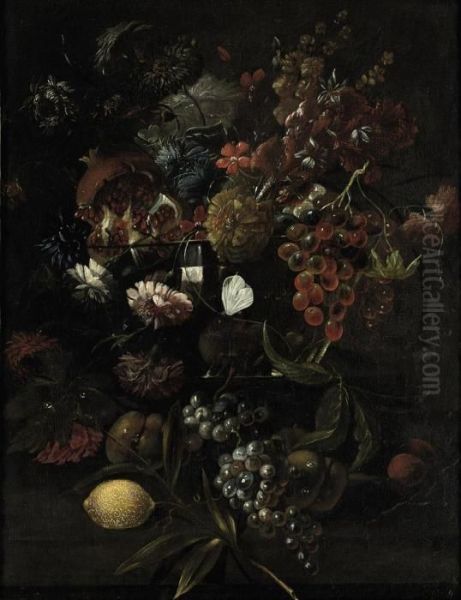
Collaboration was a hallmark of the Baroque art world, particularly in Rome, where large decorative projects and specialized genres encouraged artists to pool their talents. Mario Nuzzi was an active participant in this practice. His work with figure painters like Filippo Lauri and Carlo Maratti on specific projects, such as the Four Seasons series or the decorated mirrors, allowed for the creation of complex works that integrated different specialties seamlessly. His documented collaboration with Giovanni Maria Morandi on a flower painting further attests to his engagement with contemporaries.
Like most successful artists of his time, Nuzzi likely maintained an active workshop. This studio would have employed assistants and pupils who helped with preparing materials, painting backgrounds or less critical areas, and making copies of popular compositions. The existence of a workshop helps explain the variations in quality sometimes observed in works attributed to him and the proliferation of paintings "in the style of" Nuzzi.
His role as a teacher was also significant for the continuation of the flower painting tradition in Rome. He trained several pupils who went on to become successful artists in their own right. Among his most noted students were Laura Bernasconi and Domenico Bettoni. Through his teaching, Nuzzi disseminated his techniques and stylistic approach, ensuring that his influence extended well beyond his own lifetime and contributing to the establishment of a Roman school of floral still life painting.
Patronage, Recognition, and International Reach
Mario Nuzzi's exceptional skill and the growing fashion for still life painting brought him considerable success and recognition. He attracted patronage from some of Rome's most powerful and discerning families, including the Colonna, Barberini, Chigi, and Pamphili, who commissioned his works to adorn their lavish palaces. These aristocratic patrons valued his paintings for their beauty, technical brilliance, and the sense of cultivated luxury they conveyed. His connection with Cassiano dal Pozzo, a key figure in Roman intellectual and artistic circles, undoubtedly facilitated access to such high-level patronage.
Formal recognition came through his acceptance into prestigious artistic organizations. Sources suggest he became a member of the Congregazione dei Virtuosi al Pantheon, a distinguished society of artists, scholars, and clergy, possibly around 1647 or 1657. More significantly, he was elected an Academician of the Accademia di San Luca, Rome's official artists' academy, in 1657. Membership in the Accademia was a mark of high professional standing, confirming his status among the leading painters of his day.
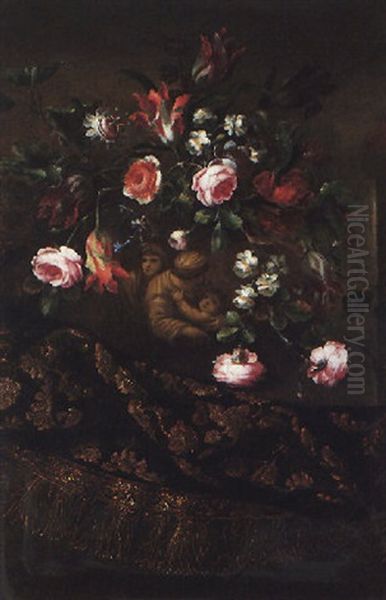
Nuzzi's fame was not confined to Italy. His exquisite flower paintings were highly sought after internationally. Records indicate that his works were acquired for the collections of the French and Spanish royal courts, demonstrating the widespread appeal of his art. This international demand underscores his position as one of the foremost European masters of floral still life in the 17th century.
Influence and Lasting Legacy
Mario Nuzzi played a pivotal role in the history of Italian art, particularly in establishing flower painting as a significant and respected genre within the Baroque tradition. Before him, still life in Italy was often considered a lesser form compared to history painting. Nuzzi, through the sheer quality, beauty, and popularity of his work, helped elevate its status. He demonstrated that the meticulous depiction of nature could be a vehicle for profound artistic expression and technical virtuosity.
His influence extended to subsequent generations of still-life painters in Rome and other parts of Italy. His students, Laura Bernasconi and Domenico Bettoni, carried forward his style, and numerous other artists imitated his compositions and techniques. This very success, however, has sometimes complicated attributions, as the works of talented followers or imitators have occasionally been mistaken for Nuzzi's own. Careful scholarly study continues to refine our understanding of his specific contributions versus those of his circle.
His legacy lies in his ability to synthesize the naturalistic impulse of Caravaggism with the decorative elegance demanded by Baroque taste. He created a style of flower painting that was both botanically convincing and aesthetically captivating, setting a standard for the genre in Italy. His works remain admired today for their technical brilliance, vibrant beauty, and as exquisite examples of Roman Baroque art.
Nuzzi in the Context of Baroque Still Life
Mario Nuzzi's career unfolded during a golden age for still life painting across Europe. While he stands as a major figure in the Italian tradition, it's useful to see his work in relation to other contemporary developments. In Northern Europe, particularly in Flanders and the Dutch Republic, flower painting had already achieved remarkable heights with artists like Jan Brueghel the Elder, Ambrosius Bosschaert the Elder, and Daniel Seghers, known for their jewel-like precision and often complex symbolic arrangements. Later Dutch masters like Jan Davidsz. de Heem and Rachel Ruysch continued this tradition of meticulous detail and opulent displays.
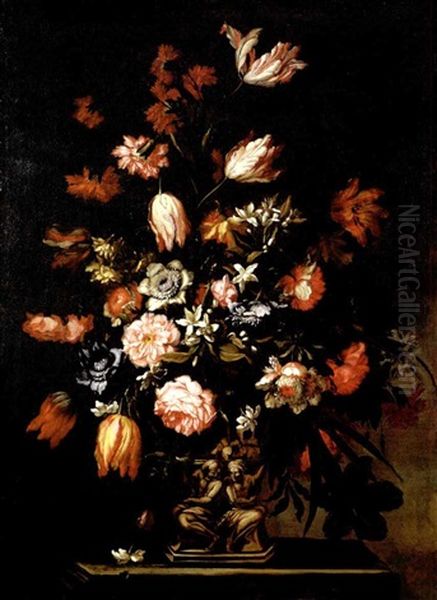
Compared to some of his Northern contemporaries, Nuzzi's style can sometimes appear slightly broader or more painterly, though still highly detailed. His lighting often retains a stronger sense of Italian Baroque drama compared to the more evenly diffused light found in many Dutch works. While Northern flower pieces frequently carried overt vanitas symbolism, Nuzzi's paintings, while acknowledging transience, often seem to prioritize decorative splendor and the celebration of nature's beauty.
Within Italy itself, Nuzzi was a leading, but not solitary, figure in still life. Earlier Lombard painters like Fede Galizia had pioneered realistic depictions of fruit, while contemporaries included Giovanna Garzoni, who specialized in delicate tempera paintings on vellum. In Naples, a distinct school of still life flourished, with artists like Paolo Porpora (with whom Nuzzi may have had contact) and later Giuseppe Recco, known for their dynamic compositions often featuring fish and other foodstuffs alongside flowers. Nuzzi's specific contribution was to firmly establish a high Baroque style of flower painting centered in Rome, characterized by its richness, naturalism, and decorative flair, deeply influenced by the Caravaggesque heritage. His work represents a significant facet of the broader Caravaggist movement's evolution, showing how its principles could be adapted to specialized genres beyond religious and mythological subjects, influencing artists far beyond the initial circle of Caravaggio, Orazio Gentileschi, or Artemisia Gentileschi.
Later Life and Death
Mario Nuzzi remained active as a painter in Rome throughout his life. He continued to enjoy patronage and fulfill commissions, maintaining his position as the city's preeminent flower painter. His workshop likely continued to produce works under his supervision, catering to the ongoing demand for his signature style. He passed away in his native city of Rome in 1673, leaving behind a substantial body of work and a significant artistic legacy.
Conclusion: An Enduring Bloom
Mario Nuzzi, "Mario dei Fiori," holds a secure and important place in the annals of art history. As a pioneer and master of Baroque flower painting in Italy, he elevated the genre through his exceptional technical skill, keen observation of nature, and innate sense of decorative beauty. His ability to infuse the naturalistic intensity of Caravaggism into the delicate subject of flowers resulted in works that are both visually stunning and historically significant. Through his paintings, his collaborations, and his students, Nuzzi shaped the course of still life painting in Rome and beyond. His lush, vibrant canvases continue to captivate viewers centuries later, offering a timeless window onto the ephemeral beauty of nature as seen through the eyes of a Baroque master.